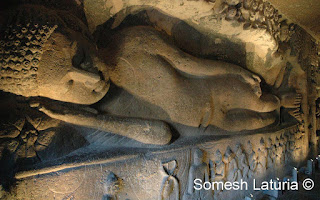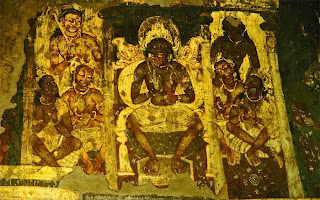(History)
These caves were discovered accidentally by a British Captain, John Smith on 28th April 1819, while he was on a hunting expedition. He had then written his name and date on a pillar in a cave (Cave # 10, Pillar # 12, from entrance of cave on right hand side) which can be seen even today. Ajanta provides a unique combination of architecture, sculpture and paintings. Two basic types of monastic Buddhist architecture are preserved at Ajanta, the Chaitya or prayer hall (Cave Nos. 9, 10, 19, 26 and 29) and Vihara or Monastery (remaining 25 Caves). These caves suggest a well defined form of architecture, broadly resolving into two phases with a time gap of about 4 Centuries from each other.
(Reach There)
The caves are in a wooded and rugged horseshoe-shaped ravine about 3½ km from the village of Ajantha. It is situated in the Aurangabad district of Maharashtra State in India (106 kilometers away from the city of Aurangabad). The nearest towns are Jalgaon (60 kilometers away) and Bhusawal (70 kilometers away). Along the bottom of the ravine runs the river Waghur, a mountain stream. One can got from either of these three places. I would suggest Bhusawal for guys going from Mumbai and Aurangabad for those who are going from Pune. There is regular bus service available from all these cities and we are not required to worry about food and rest rooms on this tour.
(About Caves)
Since 1983, the Ajanta Caves have been a UNESCO World Heritage Site. In the past, scholars divided the caves in three groups, but this is now discredited in light of fresh evidence and research. This theory of dating believed that the oldest group of caves dated from 200 BCE to CE 200, the second group belonged, approximately, to the 6th, and the third group to the 7th century. Ajanta was a kind of college monastery. There are 29 caves in Ajanta of which 9, 10, 19, 26 and 29 are Chaitya-Halls and the rest are monasteries. These caves were discovered in AD 1819 and were built up in the earlier 2nd century BC-AD. Most of the paintings in Ajanta are right from 2nd century BC-AD and some of them about the fifth century AD and continued for the next two centuries. All paintings show heavy religious influence and are centered around Buddha, Bodhisattvas, incidents from the life of Buddha and the Jatakas. The paintings are executed on a ground of mud-plaster in the tempera technique. All the rock-cut caves had paintings on verandahs, inner walls and ceilings, these revealed some of the most beautiful masterpieces of world art. In the grottos were also symbolic Buddhist mounds called Stupas, and cells for monks called Vihara. There were giant sculptures of Buddha's, Bodhisattvas (potential Buddha's), or Taras (female Buddhist divinities), as also Dwarapalas (doorkeepers). More detailed information about each cave can be read from here.
 Incomplete Caves - 3, 5, 14, 16, 18, 25, 27 and 28.
Incomplete Caves - 3, 5, 14, 16, 18, 25, 27 and 28.
I am posting some of the pictures taken by me when I visited Ajanta in April 2009.
These caves were discovered accidentally by a British Captain, John Smith on 28th April 1819, while he was on a hunting expedition. He had then written his name and date on a pillar in a cave (Cave # 10, Pillar # 12, from entrance of cave on right hand side) which can be seen even today. Ajanta provides a unique combination of architecture, sculpture and paintings. Two basic types of monastic Buddhist architecture are preserved at Ajanta, the Chaitya or prayer hall (Cave Nos. 9, 10, 19, 26 and 29) and Vihara or Monastery (remaining 25 Caves). These caves suggest a well defined form of architecture, broadly resolving into two phases with a time gap of about 4 Centuries from each other.
(Reach There)
The caves are in a wooded and rugged horseshoe-shaped ravine about 3½ km from the village of Ajantha. It is situated in the Aurangabad district of Maharashtra State in India (106 kilometers away from the city of Aurangabad). The nearest towns are Jalgaon (60 kilometers away) and Bhusawal (70 kilometers away). Along the bottom of the ravine runs the river Waghur, a mountain stream. One can got from either of these three places. I would suggest Bhusawal for guys going from Mumbai and Aurangabad for those who are going from Pune. There is regular bus service available from all these cities and we are not required to worry about food and rest rooms on this tour.
(About Caves)
Since 1983, the Ajanta Caves have been a UNESCO World Heritage Site. In the past, scholars divided the caves in three groups, but this is now discredited in light of fresh evidence and research. This theory of dating believed that the oldest group of caves dated from 200 BCE to CE 200, the second group belonged, approximately, to the 6th, and the third group to the 7th century. Ajanta was a kind of college monastery. There are 29 caves in Ajanta of which 9, 10, 19, 26 and 29 are Chaitya-Halls and the rest are monasteries. These caves were discovered in AD 1819 and were built up in the earlier 2nd century BC-AD. Most of the paintings in Ajanta are right from 2nd century BC-AD and some of them about the fifth century AD and continued for the next two centuries. All paintings show heavy religious influence and are centered around Buddha, Bodhisattvas, incidents from the life of Buddha and the Jatakas. The paintings are executed on a ground of mud-plaster in the tempera technique. All the rock-cut caves had paintings on verandahs, inner walls and ceilings, these revealed some of the most beautiful masterpieces of world art. In the grottos were also symbolic Buddhist mounds called Stupas, and cells for monks called Vihara. There were giant sculptures of Buddha's, Bodhisattvas (potential Buddha's), or Taras (female Buddhist divinities), as also Dwarapalas (doorkeepers). More detailed information about each cave can be read from here.
 Incomplete Caves - 3, 5, 14, 16, 18, 25, 27 and 28.
Incomplete Caves - 3, 5, 14, 16, 18, 25, 27 and 28. I am posting some of the pictures taken by me when I visited Ajanta in April 2009.
 Elephant Head
Elephant Head
 Beautiful Carving on Pillar
Beautiful Carving on Pillar
 Buddha in Cave # 26
Buddha in Cave # 26
 Cave # 26
Cave # 26
 Again Cave # 26
Again Cave # 26
 An Incomplete Statue in Cave # 26
An Incomplete Statue in Cave # 26








































